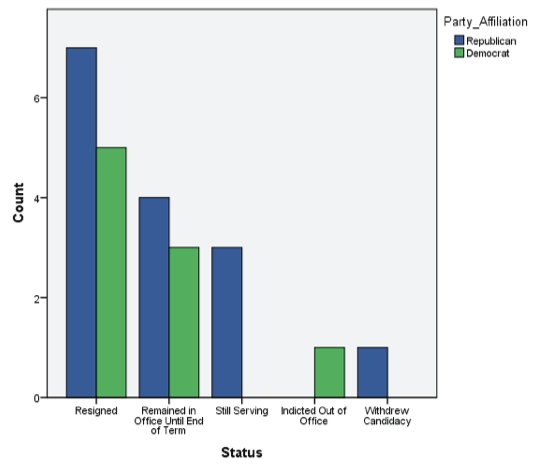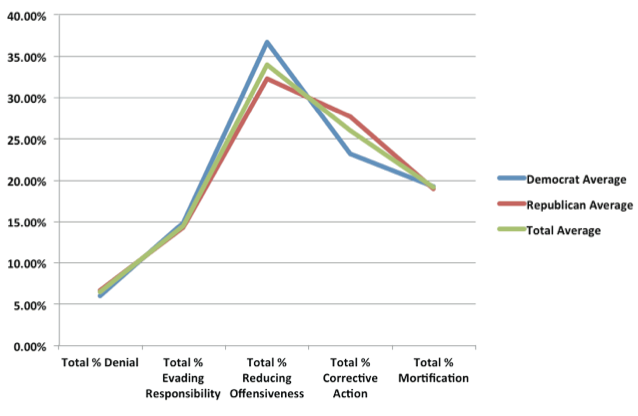- Hypothesis 1: The more forthcoming a politician is when responding to scandalous allegations, the more likely he is to regain popular support and ultimately be reelected. Due to Benoit's findings that people strive to maintain a positive reputation, especially when that reputation is threatened, it is reasonable to believe that officials will want to quickly, honestly, and delicately disseminate the facts so that they can work towards restoring their image (Benoit, 1995).
- Hypothesis 2: The increase in Internet and new media focus has forced politicians to make more statements regarding their actions. Because there are so many more outlets from which news and events can be covered, and with the advent of the 24-hour news cycle (Carpini, 2001), this research expects that officials will use a variety of media to inform their publics. More media outlets could likely mean more public statements. While the limited scope of this study does not delve into many scandals prior to the advent of the Internet and increased media scrutiny, the focus on more recent events seeks to enforce the notion that with increased media outlets comes an elevated political accountability standards.
- Hypothesis 3: Reducing offensiveness will be the Image Restoration strategy most frequently used in responding to scandalous allegations. Returning, again, to Benoit's findings, individuals are "goal driven" and committed to "maintaining a positive reputation" (Benoit, 1995). In the wake of scandal, this research presumes that strategies of reducing offensiveness, like bolstering and minimization, will be frequently used in public statements (Benoit, 1995).
As a way of collecting a comprehensive list of political sex scandals receiving national attention, a web-based search engine was used to compare lists. Using lists generated by NPR ("Sanford the Latest in a Series of Political Sex Scandals"), MSNBC ("A Decade of Sex Scandals"), and Newsweek ("Sex Scandals Through the Years: Both Parties Even"), the author then cross-referenced them to compile a list of 24 scandals. The timeframe for this research ranged from May of 1987 until June of 2011. Each of the 24 selected scandals received significant national attention and media coverage, and involved an official in an elected position (with the exception of Supreme Court Justice Clarence Thomas). The final list of scandals included 15 Republicans and 9 Democrats.
In collecting public statements, the author used a search engine to gather full texts of public statements made by each official. In some cases, she was unable to find full transcripts, and relied on comparing relevant newspaper articles that quoted their statements. As some scandals were publicized and drawn out over several years, there were more public statements for some officials than for others whose corrective action took place in a matter of hours of being publicized. As a way of coding each statement, the author used William Benoit's widely accepted five "Theories of Image Restoration," indicating each time an individual method was used (Benoit, 1995, p. 74). The five methods she coded for were:
Denial: When coding for Denial, the author looked for statements and phrases in which the official denied any accountability, or that the event even occurred. Examples of denial: "I have no personal relationship with the individual you are following" (Hart), "The story is false. It's completely untrue, ridiculous" (Edwards), "I categorically denied all of the allegations and denied that I ever attempted to date Anita Hill. I strongly reaffirm that denial" (Thomas).
Evading Responsibility: When the individual cannot categorically deny allegations, evading responsibility may be used to reduce his or her apparent responsibility. Examples of evading responsibility are "The committee has been the judge, jury, and prosecution. This process makes the Inquisition look like a study in fairness" (Packwood), "Certain members of the media have begun digging into my personal life. They have harassed innocent people in an effort to embarrass me" (Burton), "I believe the reason it happened is because I had gone through this long process where I became, at least on the outside, something different than that young boy who grew up in a small town in North Carolina" (Edwards).
Reducing Offensiveness: Coding for Reducing Offensiveness included many different efforts individuals have used to remain in positive public opinion. Examples of this are: "I know that as a public servant, I and the remarkable people with whom I worked have accomplished a great deal" (Spitzer); "Almost immediately after I said the lie, I knew that I was putting people in a very bad position and I didn't want to continue doing it" (Weiner); and "I've never asked any of my opponents to discuss their personal lives and I'm not going to discuss mine" (Sherwood).
Corrective Action: Corrective Actions occur when the individual commits to correct the issue or problem, and explains how they are going to do so. Instances where the author coded for corrective action included: "I must put it right, and I am prepared to do whatever it takes to do so" (Clinton); "I am announcing that I have resigned my seat in Congress effective immediately" (Lee); and "I made arrangements to enter a renowned in-patient facility to address my disease and related issues" (Foley).
Mortification: Mortification is the strategy in which officials confess and seek forgiveness. Examples of mortification include: "I want to, again, offer my deep, sincere apologies to all those I have let down and disappointed with these actions from my past" (Vitter); "I hope that my family, constituents, and fellow Members of Congress can accept this apology as being both genuine and heartfelt" (Massa); and "I am sorry that I have disappointed the citizens of the state of New Jersey who gave me this enormous trust" (McGreevey).
The author developed a comprehensive spreadsheet that included each official's party affiliation, office held, the state represented by each official, the year each statement was made, word count for each statement, how many specific times each strategy was used, and a percentage breakdown of how often each statement included each strategy. In this spreadsheet, each statement was broken down individually, with between one and nine public statements for each official. She also calculated the total number of statements that each official made, as well as the total number of times that each strategy was used overall.
The following spreadsheets she created then separated the scandals by party affiliation (Republican and Democrat). She then combined the frequency of each strategy in each statement so that every official had one dataset that covered all of his public statements. Instead of analyzing frequencies, she used percentages to interpret how often each official used each specific strategy. All graphs and tables were calculated using the original spreadsheet for each official, from each the relevant information was chosen.Continued on Next Page »
A Decade of Sex Scandals (2009, June 24). MSNBC First Read.
Achter, Paul J. "Narrative, Intertextuality, and Apologia in Contemporary Political Scandals." Communication Journal 65 no. 4 (Summer 2000): 318-333.
Aday, Sean, and Kathleen H. Jamieson. "When Is Presidential Behavior Public and When Is It Private?" Presidential Studies Quarterly 28.4 (1998): 856-60. Print.
Benoit, William L. Accounts, Excuses, and Apologies: a Theory of Image Restoration Strategies. Albany: State University of New York, 1995. Print.
Benoit, William L. "Image Repair Discourse and Crisis Communication." Public Relations Review 23 no. 2 (Summer 1997): 177-186.
Blaney, Joseph R. and William L. Benoit. The Clinton Scandals and the Politics of Image Restoration. CT: Praeger Publishers, 2001. Print.
Burns, Judith P. and Michael S. Bruner. "Revisiting the Theory of Image Restoration Strategies." Communication Quarterly 48 no. 1 (Winter 2000): 27-39.
Carpini, Michael X., and Bruce A. Williams. "Let Us Infotain You: Politics in the New Media Age." Mediated Politics: Communication in the Future of Democracy (2001): 160-81. Print.
Dagnes, Alison. Sex Scandals in American Politics A Multidisciplinary Approach to the Construction and Aftermath of Contemporary Political Sex Scandals. Continuum, 2011. Print.
Doherty, David & Connor M. Dowling. "Are Financial or Moral Scandals Worse? It Depends." PS: Political Science & Politics 44 (October 2011): 749-757.
Dowling, John, and Jeffrey Pfeffer. "Organizational Legitimacy: Social Values and Organizational Behavior." The Pacific Sociological Review 18.1 (1975): 122-36. Print.
Herman Cain Suspends His Presidential Campaign (2011, Dec. 3). The New York Times, pp. A1.
Just, Marion and Ann Crigler. "Leadership Image-Building: After Clinton and Watergate." Political Psychology 21 no. 2 (March 2000): 179-198.
Rosen, David S. Sex Scandal America. Toronto, Canada: Key Publishing House, 2009. Print.
Sanford the Latest in a Series of Political Sex Scandals (2009, June 24). NPR: Political Junkie.
Seeger, Matthew W. and Donayle R. Griffin Padgett. "From Image Restoration to Renewal: Approaches to Understanding Postcrisis Communication." Review of Communication 10 no. 2 (April 2010): 127-141.
Sex Scandals Through the Years: Both Parties Even (2009, June 25). Newsweek.
Thompson, John B. Political Scandal: Power and Visibility in the Media Age. Cambridge: Polity, 2000. Print. Williams, Juliet A., and Paul Apostolidis. Public Affairs: Politics in the Age of Sex Scandals. Duke University Press, 2004. Print.
Woessner, Matthew C. "Scandal, Elites, and Presidential Popularity: Considering the Importance of Cues in Public Support of the President." Presidential Studies Quarterly 35 no. 1 (March 2005): 94-115.
Appendix
Figure 1. Use of image restoration strategies by official

Figure 2. Post-scandal status of office held by year

Figure 3. Post-scandal status of office held by party affiliation

Figure 4. Average use of image restoration strategies by party affiliation

Figure 5. Image restoration strategies by year





Public Statement Transcripts by Official
David Wu
- http://www.wjla.com/articles/2011/07/in-wake-of-unwanted-sexual-encounter-allegation-congressman-davidwu-will-resign--64214.html
- http://www.oregonlive.com/politics/index.ssf/2011/08/david_wu_resigns_candidates_sc.html
Anthony Weiner
- http://news.discovery.com/tech/tweeting-in-the-public-eye.html
- http://www.nbcnewyork.com/news/local/Lewd-Photo-Sent-Over-Rep-Weiners-Hacked-Twitter-Account-122799269.html http://abcnews.go.com/US/wireStory?id=13820480
- http://www.realclearpolitics.com/articles/2011/06/06/rep_anthony_weiners_press_conference_110117.html
- http://newyork.cbslocal.com/2011/06/16/full-transcript-of-rep-anthony-weiners-resignation-speech/
David Vitter
- http://www.washingtonpost.com/wp-dyn/content/article/2007/07/16/AR2007071601348.html
- http://www.alternet.org/peek/57292/one_republican_senator's_sexual_hypocrisy_shocks_even_larry_flynt/
- http://www.washingtonpost.com/wp-dyn/content/article/2007/07/09/AR2007070902030.html
Eliot Spitzer
- http://cityroom.blogs.nytimes.com/2008/03/10/i-apologize-to-the-public/
- http://cityroom.blogs.nytimes.com/2008/03/12/full-text-of-spitzer-resignation/
Mark Souder
- http://voices.washingtonpost.com/44/2010/05/rep-mark-souder-resignation-st.html
- http://www.jgmobile.net/article/20100523/NEWS03/305239925&template=mobileart
Don Sherwood
- http://www.freerepublic.com/focus/f-news/1394532/posts
- http://www.rollcall.com/issues/52_36/-15338-1.html?zkMobileView=true
Ed Schrock
- http://www.nytimes.com/2004/08/31/politics/31virginia.html
Mark Sanford
- http://www.americanfreethought.com/wordpress/2009/07/19/if-god-cant-keep-you-out-of-trouble/
- http://www.washingtonpost.com/wp-dyn/content/article/2009/06/24/AR2009062402504.html
- http://abcnews.go.com/blogs/politics/2009/06/sanford-i-thought-i-would-resign/
- http://www.wistv.com/story/10590732/transcript-gov-mark-sanfords-wed-afternoon-pressconference?clienttype=printable
Jack Ryan
- http://www.nytimes.com/2004/06/23/us/illinois-senate-campaign-thrown-into-prurient-turmoil. html?pagewanted=all&src=pm
- http://www.ilsenate.com/
Robert Packwood
- http://www.nytimes.com/1992/11/22/us/senator-is-accused-by-several-women-of-sexual-advances.html http://www.nytimes.com/1995/09/07/us/packwood-case-overview-ethics-committee-6-0-asks-senate-oustpackwood-he-vows.html?pagewanted=all&src=pm
- http://portland.daveknows.org/2011/09/07/september-7-1995-oregon-senator-bob-packwood-announcesresignation/
- http://articles.baltimoresun.com/1994-04-01/news/1994091105_1_bob-packwood-larry-king-alcohol
James McGreevey
- http://www.nj.com/news/ledger/index.ssf?/news/mcgreevey/stories/20041109ap_mcg_farewellspeech.html
- http://www.stateline.org/live/printable/story?contentId=15737
Eric Massa
- http://www.post-journal.com/page/content.detail/id/552606/Massa-will-not-run-for-re-election.html http://www.rollcall.com/news/-43920-1.html?zkMobileView=true
- http://realclearpolitics.blogs.time.com/2010/03/05/massas-statement-of-resignation/
Tim Mahoney
- http://articles.cnn.com/2008-10-13/politics/mahoney.ethics.probe_1_ethics-lapse-abc-report-allegations?_ s=PM:POLITICS
- http://www.ethicsstupid.com/archives08/archives-posts0810/florida-water-81015.html
- http://thisnation.com/textbook/congress-rep.html
Christopher Lee
- http://voices.washingtonpost.com/postpartisan/2011/02/rep_chris_lee_r-craigslist.html
- http://abcnews.go.com/Politics/congressman-chris-lee-resigns-shirtless-photo-posted-internet/ story?id=12878937
Bob Livingston
- http://www.nytimes.com/1998/12/18/us/on-two-fronts-livingston-i-was-running-for-speaker-not-sainthood.html
- http://www.historyplace.com/speeches/gephardt-livingston.htm
Gary Hart
- http://www.nytimes.com/1987/12/16/us/no-money-no-headquarters-no-staff-but-i-m-back-in-the-race.html http://www.unc.edu/~pmeyer/Hart/hartarticle.html
- http://www.nytimes.com/1987/05/04/us/paper-and-hart-in-dispute-over-article.html?pagewanted=all&src=pm http://articles.latimes.com/1987-05-09/news/mn-4818_1_proud-man
- http://www.nytimes.com/1987/05/07/us/transcript-of-a-statement-by-hart.html
- http://www.nytimes.com/1987/05/06/us/treanscript-of-hart-s-remarks-to-newspaper-publisher-s-group. html?pagewanted=all&src=pm
Vito Fossella
- http://cityroom.blogs.nytimes.com/2008/05/08/fossella-admits-to-extramarital-affair/
- http://www.silive.com/news/index.ssf/2008/05/exclusive_fossella_will_not_se.html
Mark Foley
- http://abcnews.go.com/Politics/TheNote/story?id=2518043&page=3
- http://www.rawstory.com/news/2006/Video_Foley_attorney_claims_client_abused_1004.html
- http://articles.cnn.com/2006-09-29/politics/congressman.e.mails_1_e-mails-mails-male-page?_ s=PM:POLITICS
John Ensign
- http://www.gpo.gov/fdsys/pkg/CREC-2011-05-02/html/CREC-2011-05-02-pt1-PgS2561-4.htm
- http://s3.documentcloud.org/documents/89995/senate-ethics-report-on-john-ensign.txt
- http://www.politicususa.com/Ensign-hypocrite/
- http://www.rollcall.com/news/-205088-1.html
John Edwards
- http://abcnews.go.com/Nightline/story?id=5545029
- http://articles.latimes.com/2007/oct/12/nation/na-briefs12.s5 http://abcnews.go.com/Politics/story?id=5544981#.T5StlO15e0o
- http://articles.cnn.com/2008-08-08/politics/edwards.affair_1_edwards-campaign-aide-john-edwards-riellehunter?_s=PM:POLITICS
Larry Craig
- http://www.nytimes.com/2007/09/01/washington/01cnd-ctext.html?pagewanted=print
- http://www.foxnews.com/story/0,2933,295329,00.html http://www.deseretnews.com/article/695206485/Idaho-Sen-Larry-Craig-resigns-in-storm-over-airport-sexsting.html
- http://articles.cnn.com/2007-08-28/politics/sen.craig.statement_1_idahoans-witch-hunt-minneapolis-airport?_ s=PM:POLITICS
Bill Clinton
- http://www.washingtonpost.com/wp-srv/politics/special/clinton/stories/whatclintonsaid.htm
- http://millercenter.org/president/speeches/detail/3930 http://law2.umkc.edu/faculty/projects/ftrials/clinton/clintonstatements.html
Dan Burton
- http://articles.nydailynews.com/1998-09-02/news/18076035_1_vanity-fair-scandal-questioned
- http://www.washingtonpost.com/wp-srv/politics/special/clinton/stories/burtontext090498.htm
Save Citation » (Works with EndNote, ProCite, & Reference Manager)
APA 6th
Moran, M. (2012). "Image Restoration in Political Sex Scandals: What To Do (And What Not To Do) When You're Caught With Your Pants Down." Elon Journal of Undergraduate Research in Communications, 3(2). Retrieved from http://www.inquiriesjournal.com/a?id=832
MLA
Moran, Margaret. "Image Restoration in Political Sex Scandals: What To Do (And What Not To Do) When You're Caught With Your Pants Down." Elon Journal of Undergraduate Research in Communications 3.2 (2012). <http://www.inquiriesjournal.com/a?id=832>
Chicago 16th
Moran, Margaret. 2012. Image Restoration in Political Sex Scandals: What To Do (And What Not To Do) When You're Caught With Your Pants Down. Elon Journal of Undergraduate Research in Communications 3 (2), http://www.inquiriesjournal.com/a?id=832
Harvard
MORAN, M. 2012. Image Restoration in Political Sex Scandals: What To Do (And What Not To Do) When You're Caught With Your Pants Down. Elon Journal of Undergraduate Research in Communications [Online], 3. Available: http://www.inquiriesjournal.com/a?id=832





























